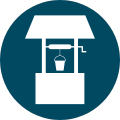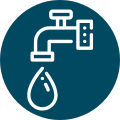
Our vision:
A safe and healthy Kitsap County for all.
Monitoring & Maintenance Certification for Resident Homeowners
Drinking Water & Onsite Sewage
You can find the complete certification requirements in Section 17 of our regulations. Requirements are summarized below for your convenience.
What You Need to Know About Properties Connected to a Septic System
A septic system is a critical part of a home. It collects, treats, and disposes of all water from toilets, sinks, tubs, showers, dishwashers, and other appliances.
Before buying or selling a home connected to a septic tank, make sure that you know the status of the septic system. Kitsap Public Health District can review records, inspect the system, and provide you with a written report of what we find. This is a great way to help protect your investment and follow regulations (Kitsap Public Health Board Ordinance 2025A-01, Section 13.D).
Before the final sale of a property, contact us for a property conveyance inspection (PCI) to identify any significant problems. Without an inspection, potential problems are not corrected and can cause major problems later on. For instance, a septic system my fail after new owners purchase a home, costing them thousands of additional dollars in repairs.
For us to perform a property conveyance inspection, we will need a record drawing. If your property does not have one, you will need to create one.
2024 Property Conveyance Inspection Findings
1,676 property conveyance inspections for septic were completed in 2024. Of those, 464 (28%) had significant deficiencies identified.
Avoiding Common Problems on Property Conveyance Inspections


Encroachment
Don’t build or park on your primary or reserve drainfield. Primary and reserve drainfield areas are intended to be maintained clear for maintenance and for future use.
Maintenance accessibility
For alternative systems, keep components accessible for maintenance.
Using beyond capacity or having unpermitted connections
Stay within the designed capacity of your drainfield design. To find out how many bedrooms your septic is approved for, search for your records through our GIS Search.
Do not add plumbing to outbuildings without project review and approval from Kitsap Health.
Compromised primary or reserve areas
Know where your septic areas are and protect them. To learn more about protecting those areas, review the Homeowner’s Guide
What You Need To Know About Properties Connected to a 1- or 2-party well or a Group B Water System
Effective March 4, 2019, all properties served by a Private or Group B Water System are required to have a Water Status Report from the Health District bfore they are sold.
Water Status Report applications (public and private) should be submitted 30 days before the property transfer to allow for any identified issues to be addressed before closing sale.
For more information, read our Private Water Status Report Frequently Asked Questions handout.
Just like a property conveyance inspection is important to know the status of a septic system, it is also important to evaluate your water system to identify significant problems.
2024 Private Water Status Report Findings
438 private water status reports were completed in 2024. Of those reports, 173 (39%) had significant problems identified.
Avoiding Common Problems on Private Water Status Reports
Construction Standards
Keep your well-head above grade and accessible (at least six inches above grade)


Well openings/access for contamination
Openings in the well casing/cap can allow contamination into the well. Ensure conduit, cap and all other entry points are sealed.
Ensure pressure tank maintenance is up to date and sample for bacteria annually. For more information about bacteria sampling, view our handout.

2024 Group B Water Status Report Findings
124 public water status reports for Group B systems were completed in 2024. Of those, 106 (84%) significant problems were identified.
Avoiding Common Problems on Public Water Status Reports
No user agreement
Group B user agreements have been required since 2019. All water systems should review their current user agreement or, if there isn’t one, create one. Learn more:
No operating permit
Group B water systems must have a current operating permit. Ensure water system contact information is up to date and the permits have been paid. For more information, visit our Group B Public Water Systems page.
No current samples
Most Group B water systems must sample annually for bacteria and every three years for nitrate. If you’re unsure of your sampling frequency or need technical assistance with taking samples, please call us at 360-728-2235 and ask to speak to the Drinking Water Inspector of the Day.
Reminder cards are mailed approximately 30 days prior to sample due date. Please make sure your system contact information is up to date.
Preparing for Certification
Obtain a valid monitoring and maintenance contract with a Health Officer certified monitoring and maintenance service provider for at least one year while completing the Single-Family Residence Owner – Monitoring and Maintenance Certification requirements of this section, or during the two (2) year warranty period for new or replacement installations.
Attend and complete at least eight (8) hours of OSS-related training from a Health Officer-approved entity, such as WOSSA.
Possess or have access to equipment and tools necessary to enable the monitoring and maintenance of onsite sewage systems in accordance with our regulations
Take the certification test at WOSSA
There is a fee for WOSSA training and testing, which the Health District does not regulate. If you visit WOSSA's website and click on education, you can find the links to training and testing.
How to apply for Certification
When you have gathered the documentation above, submit your documents and fees. Please include:
your application (completed and signed)
training documentation (8 hours)
a copy of your WOSSA test results
Please note: if any part of the submittal is missing or incomplete, your fee will be refunded and you will have to resubmit your application packet.
Demonstrating Field Competency
After completing the requirements above and submitting your application for certification the applicant shall make an appointment with the Health Officer to perform the minimum required monitoring and maintenance service on their respective OSS under the direct supervision of the Health Officer. There is a fee for this appointment based on our current standard hourly rate.
Probation
The first year of certification shall be a probation period for the Health Officer to ascertain the fitness of the applicant. The Health Officer may extend the probationary period if the applicant has not fully demonstrated: (1) Competency of OSS rules, regulations, and ordinances applicable to their onsite sewage system; and (2) The ability to perform the monitoring and maintenance service requirements on their system and submit the appropriate reports to the Health Officer.
Helpful Links
Board of Health Ordinance: https://www.kitsappublichealth.org/ehdocs/2025ossregs
Onsite Sewage System Use, Monitoring, and Maintenance Field Manual: https://www.kitsappublichealth.org/ehdocs/osspolicy1
Our Environmental Health fee schedule: https://www.kitsappublichealth.org/fees
WOSSA’s website: http://www.wossa.org/
If you have any questions about the homeowner monitoring and maintenance certification process, please contact our office at 360-728-2235 or email ossdw@kitsappublichealth.org.










.png)
